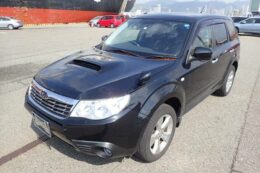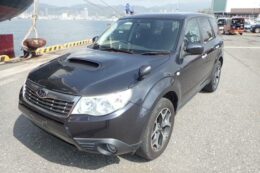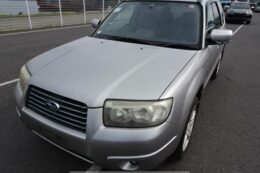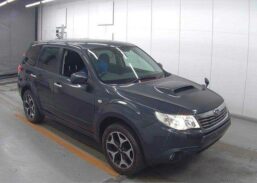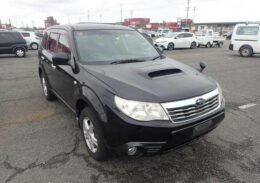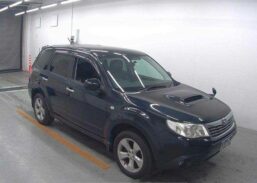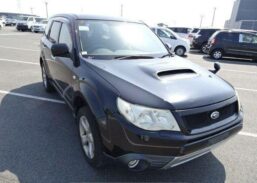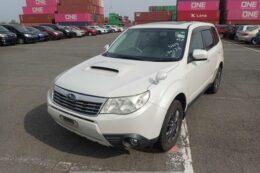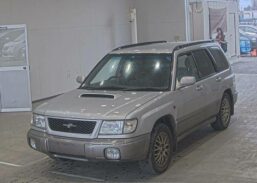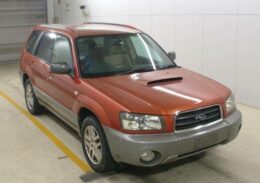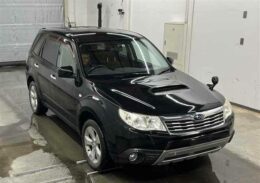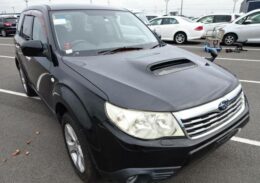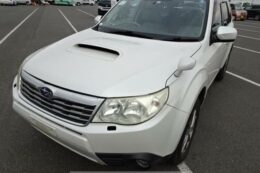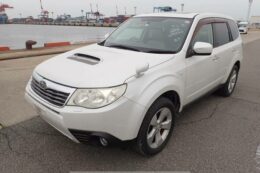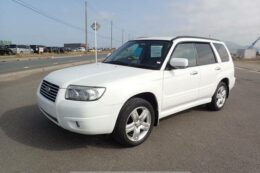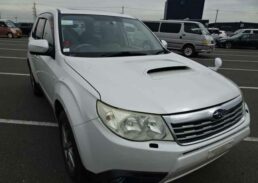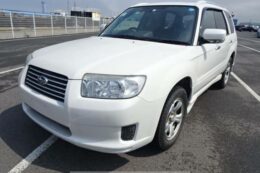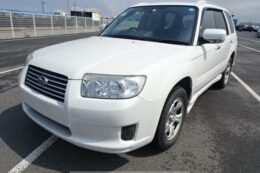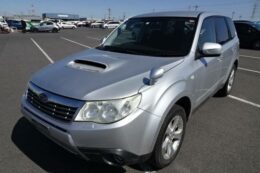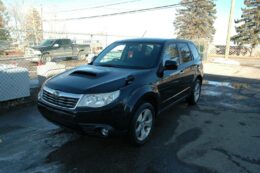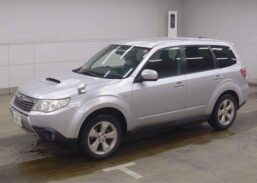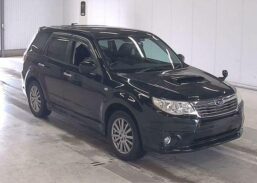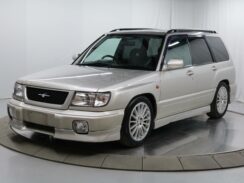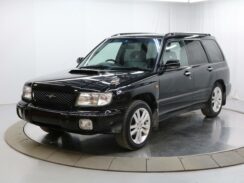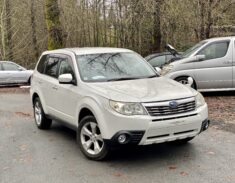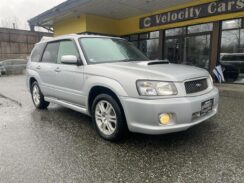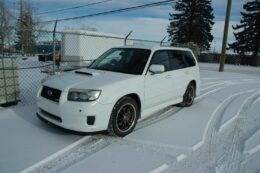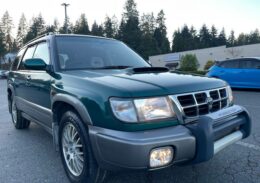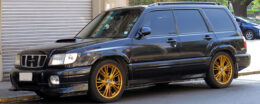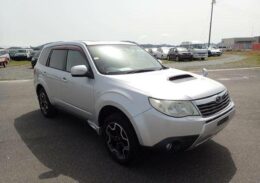
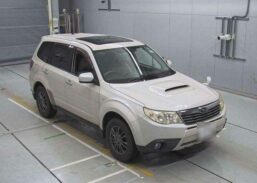
2009 SUBARU FORESTER 2.0XT PLATINUM SELECTION
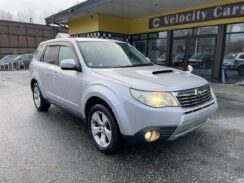
2008 Subaru Forester 2.0 XT Turbo 4WD AT 76K
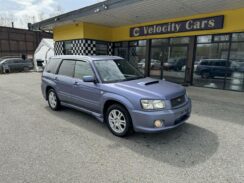
2003 Subaru Forester Cross Sports 4WD Turbo AT 88K
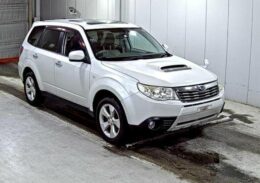
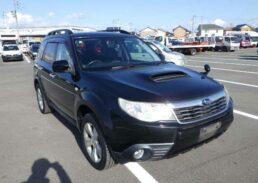
1 - 36 of 38 Subaru Forester ads
Subaru Forester Buying Guide
If you are a Subaru fan and looking for a fun car to drive and practical, the Subaru Forester is the car for you. With more ground clearance than a Legacy and the rallying DNA of the WRX STI, the Forester makes the perfect vehicle that sits between the two worlds.
Like the Legacy, AWD was a standard feature on the Subaru forester. The power was split 60/40 in Foresters with an automatic transmission. However, if the transmission detects a slip in either axle, power is split 50/50 to prevent loss of traction. The AWD system in Foresters with a manual transmission ensures that power is split 50/50 between the front and rear axles.
Some consider the Forester a wagon, but it’s not even though Subaru classifies the first two generations as wagons. The Forester is more like a small crossover SUV, and when it was launched in the States, it competed against larger SUVs such as the Jeep Cherokee.
With its boxy and rugged looks, the Forester stood out among other crossovers and was perceived to be an off-road-oriented car. It wasn’t until the S Turbo spec was released that people accepted the Forester as a more road-going car. The Forester was a more reliable and inexpensive option that was more capable than most crossovers being offered at production. Its biggest competition was the Rav4, but it was too small and had a lower power output.
The first and second-gen Foresters have plastic body cladding, unpainted in the base spec models. This is one of the things that was hated at first but embraced later as the cost of replacing the body claddings was low. Some would switch the painted body claddings with unpainted ones, especially if the Forester was used off-road.
Subaru made more turbocharged and STI spec Foresters than Legacies which makes the Forester a favourite among wagon fanatics. In 2008 (third-gen Forester), Subaru discontinued the frameless windows on the Forester just like they did with the fourth-generation legacy in 2009. Basically, any Subaru produced from 2008 did not carry any design similarities that have been there in earlier generations.
The last EJ engines on the Forester were used in the third generation, but not too many as Subaru mainly used the FA and FB engines. The introduction of CVT also made buyers shy off from buying Foresters, but there’s a 5-speed manual option. The 6-speed manual option is only available in Foresters with the 2.5-litre EJ25 turbodiesel or the STi spec.
First and second-gen Fozzys (Forester nickname) are cheap, reliable, and fun to drive. Non-STi spec Fozzys will cost you around $4,000, while STI versions start at $7,000. Foresters are cheap than Legacies and Imprezas and still offer the best characteristics from both worlds.
Pros and Cons
Pros
Affordable
Suppose you have 5,000 bucks hidden somewhere, and you’re looking for a 2000s JDM crossover/wagon, whatever you decide to call it. In that case, the Subaru Forester is the perfect fit. With prices starting at around $5,000, there’s no better car you can get. Even for higher specs such as the Forester STi or XT, it’s still worth it, considering Subaru doesn’t make the Forester as well as they used to. The Forester is among the few AWD JDM vehicles you can get.
Reliable
Banter is thrown at EJ engines for head gasket failures, but they are some of the most reliable engines. Base spec Foresters have the EJ20, which averages around 27mpg. For the turbocharge EJ20 and EJ25 engines, fuel consumption will be around 23-25mpg.
Reliability is not always about fuel consumption. If a car has high maintenance costs, it has a high ownership cost deeming it unreliable. The Subaru Forester has a reliability rating of 3.8/5.0, positioning it among cars that have average ownership costs. Which is not bad for a 20-year-old car.
Can be driven on any road surface
Foresters are everywhere, on race tracks, highways, and even wild. The Forester is rugged in appearance, but it can also handle any terrain you throw at it even though it lacks driver aids such as locking diffs or a four-wheel-drive system.
The entry-level Forester is the perfect car if you want to modify it for Overlanding or off-roading. STI and S-turbo specs have a lower ride height, and keeping them on the road is most appropriate. STI parts are readily available, and if you want to turn your entry-level Forester into an STi, you can do it.
Practical
The Subaru forester makes the perfect daily driver. It has enough cabin space to fit five people and enough trunk space to fit bags for the whole squad when going on a ski expedition. It came standard with roof rails, and if they are still on, you can mount a roof rack for extra storage.
Fun to drive
Since all foresters are AWD, you can drive them on any surface, including ice or mud, without worrying about getting stuck. Drifting with an AWD car is hard to master for a beginner but tons of fun to do when you learn how to do it.
The EJ engine rumble is orgasmic to listen to when cruising the highway, especially if you have a straight piped EJ20 turbo or EJ25 turbo. The urge to accelerate, downshift and listen to the turbo flutter and the pops and bangs from the exhaust is every Fozzy fanboy’s dream.
Great handling
An AWD system that ensures traction on all four wheels is important when driving on snow, mud, or even the road surface. Pre-2000 models have rear drum brakes, but you can swap to disc brakes standard on every Forester after 2000. ABS was also made standard after 2000, after which the Forester was awarded a 5-star safety rating by the NHTSA.
Regardless of its raised ride height, the Forester has a low center of gravity, enabling ride stability. This is contributed by Subaru’s engine and transmission placement, where they place the engine in line with the transmission. This also reduces engine movement, which prevents the center of gravity from swaying when cornering or braking.
Parts are easily available and inexpensive
Many aftermarket manufacturers still make the engine, transmission, suspension, and body parts for the Subaru Forester. Most of which are easy to find and cheap, just like the initial cost of buying a forester. If you are buying a Forester as a project car, you can buy one that is running but with minor issues. This saves you some cash to buy aftermarket or OEM parts to turn your Fozzy into the ultimate sleeper.
Cons
Base trim Foresters don’t have airbags
This is probably the biggest red flag in a Forester. Some base trim pre-2000 Fozzys did not have airbags, but it was later a standard feature on all trims. When buying a Forester made before 2000, ensure you check if it has an airbag. Some owners had OEM or aftermarket airbags installed.
If the car doesn’t have an airbag, bargain for the price, then install an airbag afterward. For a car that you want to drive long miles with or explore trails with, safety is paramount, and an airbag is one of the most basic safety features you should have installed.
Low maximum towing limit
The Forester was not made to compete with bigger SUVs, but it sure did put out a good fight in the early years of production. However, the towing capacity is one area where the Forester is highly disadvantaged compared to larger SUVs.
The first and second-gen Foresters have a maximum towing capacity of around 2500 pounds which is twice as less as the SUVs it was competing against. The unavailability of a tow hitch in some models also meant that you had to get one installed to haul your small trailer.
Poor quality interior
The interior of a Subaru Forester is not really that good. For example, the first-generation Forester has an interior and comfort rating of 3.4, which is below average. When most cars had power windows and doors, Subaru was still installing mechanical door locks and windows on the first-generation Forester. This is one reason some will choose a Legacy wagon over a Forester.
Legacies are generally more comfortable riding or driving than Forester, mainly because of the interior. The plastic dash, door panels, and center console rattle after use and abuse and, at times, even crack. The fabric on the seats is too cheap and tears very easily. Few Fozzys came with leather seats and a steering wheel, so if you plan to use yours frequently, this is among the first upgrades you should work on.
Common Issues
Oil and Coolant leaks
Oil and coolant leaks are common in EJ engines. Oil leaking from the front of the engine indicates alternator belt tensioner failure. Replacing the belt tensioner with an OEM one or a recommended aftermarket one solves this.
The camshaft rubber seals wear out with use and abuse. It is recommended to replace the camshaft rubber seals when replacing the timing belt since you have to remove the timing belt to get to the camshaft seals. However, if too much oil is leaking through the camshaft seals, replace them.
EJ engines use single-layer head gaskets that wear out quicker than multi-layer head gaskets. When the head gaskets wear out, it results in oil and coolant leaks, eventually leading to the engine overheating.
High Oil Consumption
EJ engines are known to have a slightly higher oil consumption, especially those made in the early 90s and 2000s. But suppose you notice that the engine is consuming more oil than usual. In that case, you need to get your engine checked before an engine rebuild becomes the only way out.
The engine might be leaking oil, and you already know how to fix that. Another reason why the engine is consuming too much oil might be because of worn piston rings, which allow oil to get into the combustion chamber. If the gaskets and seals check out, you’ll have to assess the condition of the piston rings.
High oil consumption sometimes is a result of the end-user. Some drivers will assume that an EJ engine has a high oil consumption and put in more than the required amount. This floods the engine with oil, and pressure build-up will force the oil into the combustion chamber; thus, the engine will burn more oil.
Clutch Failure
This mainly occurs in Foresters with a manual transmission. As the transmission wears out, the clutch pedal becomes spongy, and you have to double shift when shifting through gears. The clutch will also produce an odor, especially when going uphill or under a heavy load. Depending on your driving habits, you should replace the clutch on a Forester after every 40,000-50,000 miles.
Broken and Failing Interior Electricals and Components
Foresters have a poor-quality interior that wears out with old age, especially if the car was stored wrongly or stored for a long time without any maintenance.
The seats, dashboard, and other plastic interior trims will fade, crack, and you’ll regret not upgrading the interior when you had the chance to. If the interior is original, it might not wear out quickly, but it will take some extreme care.
The power window switches sometimes fail or get stuck, and even the radio doesn’t work. It takes some slapping on the dash to get the radio working. Still, you’ll have to get better window switches and rewire every electrical component in the cabin to prevent future troubles.
Engine Piston Slap
This is caused by damaged or worn-out pistons that knock on the cylinders’ walls. Or the cylinder walls are worn out from damage by the previously damaged pistons that were removed. Replacing worn-out pistons is the only way you can permanently avoid this.
If the pistons are not too damaged, you can use thicker oil as you wait for replacement pistons to ship in or save some cash to buy new pistons. Opting to keep the damaged pistons means that you have to reduce driving your Fozzy and drive at low speeds when completely necessary.
Rough Suspension
The coil springs on entry-level foresters are not that great for a car that can be driven on all road surfaces. Coil springs tend to crack rust and lose tension as the car is driven and ages, resulting in a bumpy and noisy ride.
It is recommended that you replace all four coil springs, as replacing one or two will lead to an uneven ride height. The side with the new coils will appear raised than the side with the old springs. Even if the old ones are in good condition, they’ll wear out quicker than the new ones.
Cracked Windshield and Windows
The windshield and window glass quality was not that great at the production time. If the car still has the original windshield and windows, you’ll have to be extra careful or risk cracking. Most assume that because the Subaru forester has frameless windows, they will break regardless of the glass quality. Frameless windows do not affect window strength and the safety of the driver and passengers inside.
Average Prices
The Forester is among the cheapest JDM wagons you can buy. Some may classify it as a small crossover SUV, but whatever you decide to call it, it’s one of the few cars with value for money. You can easily pick one in pristine condition for just under $5,000, while STIs go for figures above $7,000. If you’re looking to save some cash, find one listed with minor issues, and you have a few bargaining points that will get the seller to lower the price.
Comparable Alternatives
Models and specifications
1997-2002 Subaru Legacy (SF)
After the discontinued Legacy Outback, the Forester was unveiled in Japan, and production started in 1997. It shared the same platform with the AWD Legacy and had similar engine options. The Legacy Outback was still in production in the USA, and the Forester was launched after production started in Japan.
The base-spec model in Japan had the naturally aspirated 2.0-liter EJ20, while the naturally aspirated EJ25 was used in base-spec Foresters in other markets.
You get the first-gen Forester with either a 4-speed automatic transmission or a 5-speed manual. The 6-speed manual was not available until the second-gen Forester STI.
Forester L
This is the base Spec Forester for the US market. It has the 2.5-liter EJ25, which had a power output of around 150 horsepower when new. The Japan base spec model was basically known as the Forester with the 2.0 EJ20, which made 136 horsepower at the time of production.
The only difference between the US and US base spec forester is engine displacement. Both models had ABS, cruise control, power locks, fog lights, bolstered seats, and standard.
After 2000, a roof rack, power windows, power doors, three-point seatbelts, and airbags were standard for both markets.
Forester S
The Forester S was launched in 2000 with the turbocharged EJ20, and it’s sportier than the L trim. It features rear disc brakes, an LSD, and a lowered sporty suspension. It was also more comfortable and driver-friendly as it had heated front seats, a windshield, and a rear-view mirror. This means that you don’t have to stand in the snow scraping ice on your windows, and you don’t have to wipe the rear-view mirror when driving in the snow.
Subaru also upgraded and replaced the steelies with new alloy wheels that matched the titanium paint. The premium package gave the Forester a new Red Pearl paint, power moonroof, side-impact airbags, and gold accent wheels.
2002-2008 Subaru Legacy (SG)
The second-gen Forester has smoother body lines and a less rugged look than the first-gen Forester. Subaru discontinued the Legacy platform used in the first-generation Forester as the second-gen has the Impreza’s AWD platform.
All trims of the second-gen Forester had an optional luxury trim which added a sunroof, leather seats, leather-wrapped shift knob, and steering wheel. The Weekender trim also added roof rails, fog lights, and alloy wheels on the base spec Forester X and XS trims.
The Forester was unavailable in China until 2004. A Chinese manufacturer, Yema, made a look-alike that shared nothing apart from looks with the Forester. Subaru exported and sold the Forester in China between 2004 and 2007.
Foresters sold in China had the same specs as Japanese specs Foresters, but the trims were badged differently. The base trim with the EJ20 is the Forester 2.0X, and the 2.5X has the naturally aspirated EJ25. All trims either have a 4-speed automatic transmission or a 5-speed manual transmission. At the same time, the STI spec only came with a 6-speed manual transmission.
Forester X
In all markets, the Forester X replaced the L Spec Forester, the base trim in the first generation. No changes were made to the engine options. The Japanese spec Forester X came with the naturally aspirated EJ20, while the EJ25 was standard in all other markets.
The EJ20 made around 140 horsepower, and the EJ25 made 156 horsepower at production. ABS, air conditioning, power windows and doors, cruise control, and rear disc brakes were standard in the second-gen base model.
Forester XS
The Forester XS was the sportier version of the X trim and had the same EJ20 and EJ25 engines in the Forester X with no change in power output. Auto Levelling suspension was first installed on the Forester XS, enabling vehicle stability by preventing a change in ride height regardless of the load.
Other additional features include; 16-inch alloy wheels, fog lights, climate control, a 6-CD changer, and all standard features in the Forester X.
Forester XT
The XT badge was used internationally and on Foresters with the 2.5-liter turbocharged EJ25. If you are on a budget and can’t get an STI, why not get an XT? The XT had a power output of 230 horsepower at production, and you can get one with either an automatic or manual transmission.
It has all features available on the XS but with 17-inch alloy wheels, HID (High-Intensity Discharge) headlights, a MOMO steering wheel, and a 7-speaker stereo.
Forester Cross Sports
This trim was derived from the Forester XT but did not have the EJ25 turbo. Instead, the Forester Cross Sports has the 2.0-litre EJ20, making 230 horsepower when new, and only has a 4-speed automatic transmission. Suppose you want a Forester that combined comfort and reliability but still makes a decent amount of power. In that case, the Forester Cross Sports is the spec to go for.
Forester STi
In 2004 Subaru launched the SG STi, the sportiest version of the second-gen Forester. The STi spec Forester was solely made for Japan and shared several Impreza WRX STi features. It received a facelifted front end with a new bumper and headlights. STi badging was embedded onto the grill and the fog light covers.
The STi has a lighter aluminum hood with a huge functional hood scoop. You get a wing, different headlights from the standard SG Forester and STi badging under the Forester badge on the rear end.
You get a turbocharged EJ25 which made close to 300 horsepower when new and has loads of tuning potential. Due to the increment in power, Subaru had to rework the suspension. It included sports springs, repositioned struts, more oversized anti-roll bars, and cross-members. The Forester STi also got bigger 18-inch wheels and Brembo brake callipers for that extra grip and stopping power.
The STi bucket seats in the Forester STi are also from the Impreza WRX STi. Other interior upgrades include a leather steering wheel. All other features are just like in the Forester XT.
FAQ
1998-2000. This is mainly because of safety issues, as airbags were not standard on the first-generation Forester. The interior quality was also not that great and might cost you a few hundred bucks to rejuvenate.
Yes. The STI has a powerful and better engine than the EJ25 used in the Forester XT. Suppose you want to turn your Forester XT or any other SG forester into an STi. In that case, body panels and badges are readily available, and there’s a chance you might get some OEM ones.
es. If you are looking for a sign to buy an SF or SG forester, this is it. Foresters make reliable daily drivers, which are fun to drive and quicker than most modern cars. The Forester STi and XT trims are even faster and look better than Foresters produced after 2008.
A Subaru forester will last you around 250,000 miles before you need to start replacing major components. Luckily Subaru dealerships still service and sell replacement firsts for Foresters if you want OEM parts replacement for your Fozzy.
Yes. But you must be aware that EJ engines can only put out a maximum of around 300 horsepower with stock internals. If your engine is in good condition, it will be easy to tune with a few upgrade parts. If it has issues, replace whatever is broken or faulty before you start doing mods. With a light tune and some weight shedding, you might actually stand a chance against stock Skylines and Supras.
Yes. Most beginners will have a low budget when buying a car, and the Forester sits among the few vehicles that are fun to drive, and you can get on a budget. Also, If you are looking for the perfect daily driver sleeper wagon, the Forester is just excellent.
How to import a Subaru Forester
Read our ultimate guide, How to Import a Car from Japan.
- Recommended Reading:
